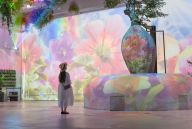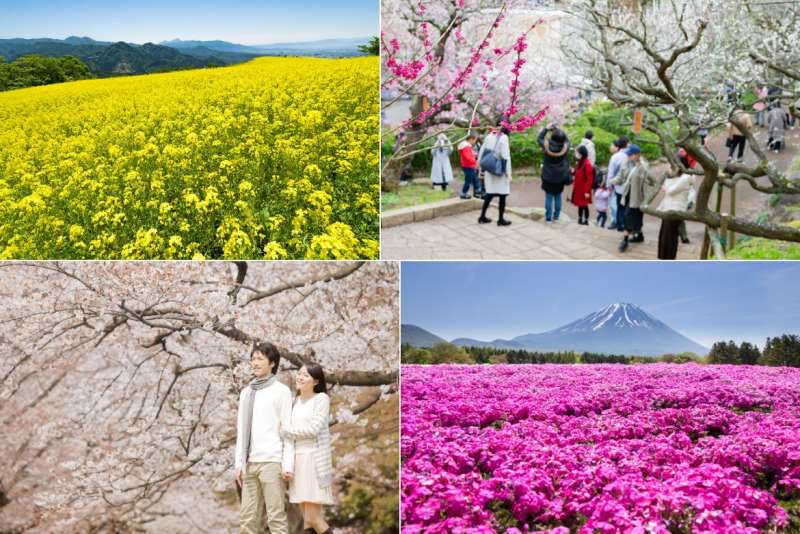
Sakura and More: 4 Other Flowers that Bloom in Spring
The image of sakura or cherry blossom comes to mind when thinking of spring flowers in Japan. But there are also other spring flowers that bloom from January to June–plum blossoms, rape blossoms, tulips, nemophila (baby blue eyes), and roses, to name a few. Here’s information on the best time to see these flowers and their recommended viewing spots. These flowers are just as attractive as cherry blossoms, so be sure to check them out during your trip to Japan!
1. Plum blossoms herald the start of spring
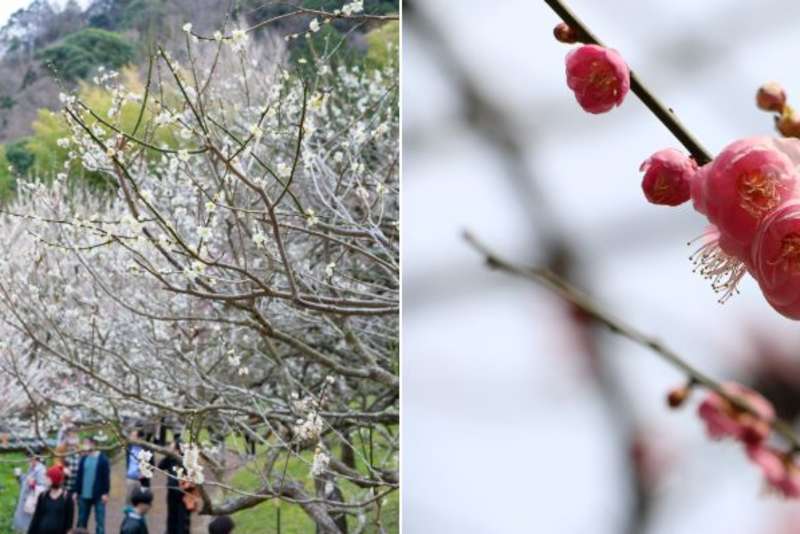
Plum blossoms are usually in full bloom in February and March and sometimes they start to bloom as early as the end of the year. This flower signals the arrival of spring before other flowers come in to join the spring vibe. Plum blossoms give off a sweet aroma and depending on the type, their shades range from dark pink to light pink and white, and they have many petals. Take a close look at them when you happen to be in Japan during the plum blossom season.
Recommended Spot: Atami Plum Garden
Atami Plum Garden is a spot where the earliest blooming plums in Japan can be seen. In this historic plum garden where 469 plum trees of 60 varieties are planted, there are centuries-old plum trees, and red and white plum blossoms that bloom in the park during the flowering season. The Atami Plum Garden Plum Festival is held annually from the beginning of January to the beginning of March, and is packed with a great number of visitors. During this period, foot-bath facilities and souvenir shops are open in the park. Other events like street performances and free amazake (Japanese traditional sweet drink made from rice and sake lees) are also expected. It takes about 15 minutes by bus from JR Atami Station bound for Ainohara Housing Complex, getting off at the Umezono Bus Stop.
Operating hours: 8:30 a.m. to 4 p.m.
Admission Fee:
Plum Festival season (January to early March)
・General ¥300
・Groups (11 people or more) ¥200
・Citizens and guests ¥100(ID is needed)
・Junior high school students and under: Free
*Entrance is free after park hours
※Entrance fee is free. But there is an admission fee during the plum festival. Please check the official website for the latest details.
※Event contents may be canceled or changed depending on the novel coronavirus situation.
2. A sprawling yellow carpet of rape blossoms
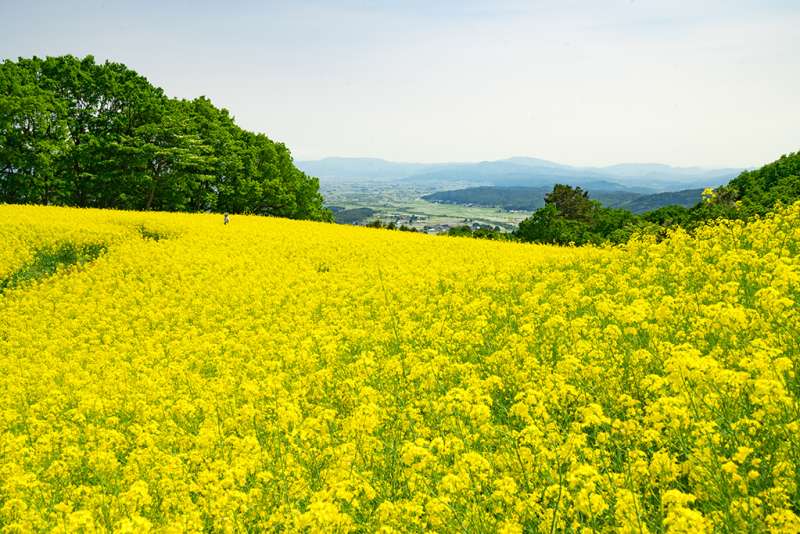
The rape field, which covers the ground in yellow, is one of the landscapes that will make you feel the arrival of spring. There are famous places for viewing them across the country, but the time when flowering begins varies depending on the area and spot. Rape blossoms bloom from January in areas with a warm climate such as Kyushu, and from May to June in areas such as those in the Tohoku area. Also, unlike cherry blossoms that don’t take long to fall, the flowering period of rape blossoms is quite lengthy, usually two to three months, so there are lots of chances for you to admire them during spring.
Recommended spot No. 1: Sannokura Kogen (Fukushima)
Sannokura Ski Resort in Fukushima is recommended as a rape blossom viewing spot, as the flowers are in full bloom across an area of about 8.3 hectares. The flowering season is from mid-May to early June, when around 3.5 million rape blossoms are in full bloom. Rape blossoms mean "bells of happiness" in flower language, so be sure to ring a bell to commemorate your visit! It takes about 30 minutes by taxi from JR Kitakata Station.
※Entrance fee is free
Recommended spot No. 2: Nokonoshima Island Park(Fukuoka)
Nokonoshima Island, located in Hakata Bay, Fukuoka, is one of the best flower viewing spots in the prefecture, as it has rape blossoms, cherry blossoms, cosmos, and daffodils. Nokonoshima Island Park is particularly recommended as a rape blossom viewing spot from late February to mid-April. The contrast between the vast yellow rape field and the blue sea and sky is absolutely breathtaking! An illumination event is held during the cherry blossom season from late March to early April, so you can see the cherry blossoms and rape blossoms in the night scenery! To access Nokonoshima Island Park, take the Nishitetsu Bus Tenjin Express Bus Terminal Mae for about 30 minutes then get off at Noko Tosenba.
※There is a fee to enter the park. Please check the official website for the latest details.
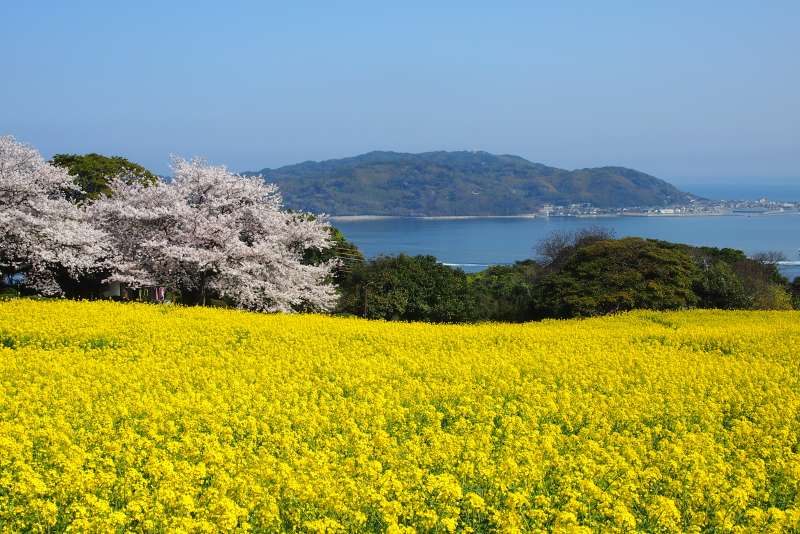
3. A beautiful waterfall of purple wisteria

Wisteria is in full bloom from late April to early May. The sight of purple, white, pink, and yellow wisteria hanging from a trellis and giving off a sweet aroma simply warms the heart. Other than Shibukawa Park, there are more spots across Japan to see wisteria, such as Ashikaga Flower Park (Ashikaga, Tochigi Prefecture) and Kameido Tenjin Shrine (Koto Ward, Tokyo).
Recommended spot: Shibukawa Park (Okayama)
Shibukawa Park is known for having Japan’s longest wisteria trellis (around 900 meters). The Shibukawa Fuji Festival is held when the flowers bloom from late April to early May, and it can get crowded with lots of tourists. When you can, try the sake Tama no Fuji Roman, made from wisteria fruit. It takes about an hour and 10 minutes via a limited express bus bound for Shibukawa from JR Okayama Station to get here.
※Entrance is free
4. A vibrant pink carpet of moss phlox
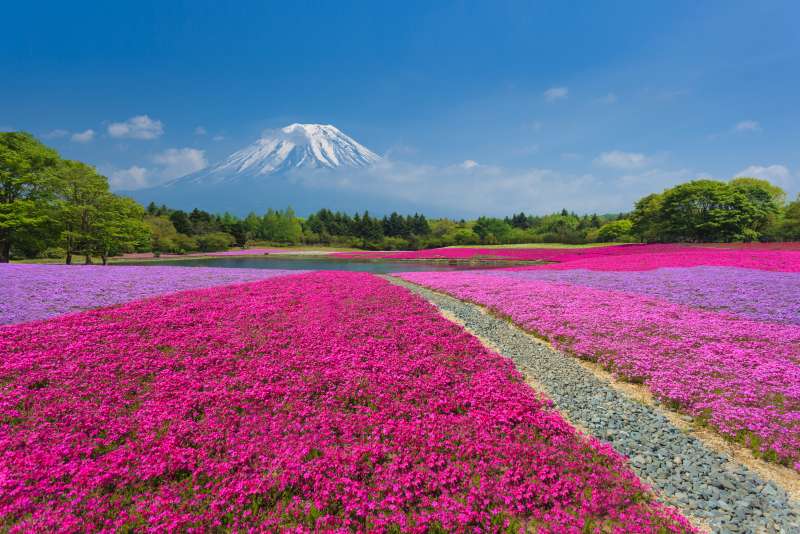
Moss phlox is a completely different variety from the Yoshino cherry, which is well-known among Japanese cherry blossoms (a perennial plant of the phlox family). Moss phlox is also called shibazakura (lawn cherry) because its flowers, shaped like cherry blossoms, cover the entire area like a lawn. Due to the overlapping tiny flowers all around the area, it looks just like a pink carpet. The best time to see moss phlox is from early May to early June.
※There is a fee to enter the park. Please check the official website for the latest details.
Recommended spot: Lake Kawaguchi(Yamanashi)
The Fuji Shiba-Zakura Festival, which is held from mid-April to late May annually, is one of the most popular spots to view moss phlox. Up to 800,000 moss phlox planted in the city area are in full bloom, and visitors can take in a magnificent view of Mt. Fuji and the vibrant moss phlox. To access the event venue, Fuji Motosu Resort, it takes about 30 minutes by bus from Kawaguchiko Station on the Fujikyuko Line.
Here are more flowers from spring to early summer!

Nemophila is in full bloom from early April to early May and sprawls across a field like a blue carpet. Hydrangea adds color during the rainy season (late May to late June), and azalea, which comes in pink, white, and red, blooms from late March to early April. Please check the list below for the best time to view these beautiful flowers in Japan.
※This list is only a guide. It is recommended that you check the blooming information before you go, as the time of blooming flowers and the time of year may vary depending on the region and climate.

Refer to the following for more information on the facilities mentioned in this article.
https://www.japan.travel/en/travel-directory/Flower/
Atami
https://www.japan.travel/en/travel-directory/Atami/
https://travel.ataminews.gr.jp/en/
Sannokura Kogen
http://www.kitakata-kanko.jp/category/detail.php?id=109
Nokonoshima
https://www.japan.travel/en/travel-directory/Nokonoshima/
http://nokonoshima.com/en/
Shibukawa Park
https://www.city.tamano.lg.jp/site/guide/5390.html
Lake Kawaguchi
http://www.shibazakura.jp/















































